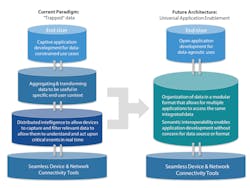Latest from IoT
Sponsored
In the last chapter in our story of our DX (Digital Transformation), entitled, Edge-ifcation in the Era of Connection I wrote, “Together we are starting an interesting, important discussion and – to one degree or another – participating in the necessary disruption that is driving that transformation.”
That same column ends with, “That is all we do, connect things to things, so we created the first ever Connection Community Collaboratory. Please come and join the discussion of industry leaders in Atlanta at AHRExpo and help us better define our human role in the connected-building era. Exploring Our Human Connection: 7th Annual Connection Community Collaboratory."
We are all part of several connection communities, but reorganizing our existing ones and creating our new ones is now foremost on all our minds. So I want to pick up where our last chapter left off with the interesting, important discussion: Why do we need to change?
Here is some big picture advice of our connection communities failures with amazing resources on how to change from Harbor Research, The Failure of IoT Platforms, Creative Evolution and the Post-Platform Era:
Today, platforms for the Internet of Things are still a kludgy collection of yesterday’s technology and architectures that do not address the most basic development challenges. Even though many companies are telling fantastic IoT marketing stories about what their solutions can do, you wouldn’t know it from today’s fragmented collection of incomplete platforms, narrow point-solutions, and software incompatibility.
We need better software to empower users and developers to exploit the vast potential of the Internet of Things.
Also from Harbor is a downloadable pdf, Smart Systems Architecture Evolution. It opens with:
The key to accessing and leveraging the data necessary to inform new applications in a data-services economy is the formation of collaborative communities which bring complimentary systems, players and data streams together to benefit diverse users. Ecosystems, collaborative communities, and new value networks will be self-organized by people who are motivated to explore and develop ideas they care deeply about.
New technologies to enable collaborative innovation will extend beyond ideas about new products and new services to the very manner in which business is conducted. Open collaborative communities and ecosystems will be designed and driven by many diverse and often unfamiliar stakeholders and businesses; what we like to call “strange bedfellows.” The era of “flying solo” is over. The drive to partner with emergent start-ups and developer communities presents enormous cultural challenges to product OEMs that have built monolithic after-market monitoring, services and parts businesses based on closed, proprietary “command and control” technologies.
Platform business models that creatively combine elements of dis-intermediation, new relationships, shifting profit pools, new recurring services, customer transparency or other maneuvers are all disrupting existing business and operating models - just consider the scale and impact of technology-based platform models like Google, Apple, Amazon, and Facebook.
(I recommend you download the entire 19 page pdf for a big picture read.)
So what should our smart, automated building, collaborative connection communities look like, and how will they promote change?
This article by Pook-Ping Yao, CEO, Optigo Networks, asks the right questions while providing some clear answers, Is our industry Building-IoT ready? Choice quote:
Acuity’s a lighting company. They acquired Distech, DGLogik, and Lucid. Within two years, they went from a traditional, metal and lightbulbs company to a force to be reckoned with. The company now brings digitalization to lighting and building automation systems, with visualization, analytics, and the cloud.
Siemens, one of the traditional big four, is also shifting into this B-IoT space. They’ve gone on a huge buying spree in recent months, acquiring J2 Innovations, Enlighted, and Comfy. These companies “wake up” our brick and mortar buildings at every level — from the framework and analytics to all the bits in between that keep us comfortable.
Companies like Acuity and Siemens don’t want to get left behind by disruptors of the new age. These acquisitions are their insurance against obsolescence.
This interview of Pook-Ping Yao by Monica McMahen, Director of Marketing, Optigo Networks on The Future of BACnet follows up with the changes happening in the BACnet connection community:
Pook-Ping Yao: Well, I’m very excited by the new updates coming out with BACnet Secure Connect. It’s going to address issues of authentication and encryption, and it’s going to better align with IT security standards. I think this will help make BACnet devices more secure, but it will also make it a lot easier for IT and OT teams to work together. Suddenly there’s common ground, a common vocabulary that we can come together on. I think there’s still a lot of progress that can be made in BACnet, and especially in educating the community, but this is a big step for the protocol.
Then we have Haystack a newer connection communities collaboration with ASHRAE BACnet
Last April Project Haystack entered into a formal collaboration to integrate Haystack tagging and Brick data modeling concepts into the proposed ASHRAE Standard 223P for semantic tagging of building data.
There are several exciting happenings and events taking place with Project Haystack. Here’s a quick update from John Petze, Executive Director, and Marc Petock, Secretary, Project Haystack.
Meanwhile, on the platform side, James McHale, Managing Director, Memoori, writes about how Microsoft’s Azure Digital Twins Platform Could Disrupt Cloud Computing for the Building IoT:
In buildings, physical structures intersect with complex systems, which in turn interact with one another. Smart buildings have brought another layer to these facilities, a plethora of sensors and intelligent solutions that support the unique objectives of each building. All of this interacts with the dynamic element of people who occupy and visit the facility. Modeling such a complex environment is a challenge but unlocks a wide range of potential benefits for our buildings.
The digital twin is not new to Azure either. In fact, many companies have been building their own versions of digital twins on the Azure cloud service for years. Those third party versions consistently struggled to scale, however, which is what makes this announcement so exciting. The Internet of Things has opened up a huge market for cloud services, but Microsoft faces stiff competition from the likes of Oracle and Amazon. By offering an off-the-shelf digital twin capability like this, Microsoft may have found a “killer app” that will draw a significant portion of the market to standardize their entire Building IoT workloads on Azure.
New connection communities are evolving, what is the new deal? Here's a discussion in this new deal interview between Nicolas Waern, CEO of Nordic IoT and Anto Budiardjo, Fractional Entrepreneur, speaks to the changes needed,
Anto Budiardjo: What advice would you give readers on making the most of Facility IT?
Nicolas Waern: The best option in this turbulent world is to take the right decisions. The second best option is to take the wrong decisions. And the third is to take no decision at all.
I think it really depends on who the reader is and what they want to achieve. Again, don’t focus on technology but rather give it a benefit-driven, outside-in approach. The outside-in perspective is crucial in today's environment, and companies will have a much better chance of making the most of Facility IT also thinking about product market fit from the get-go. Focus on doing the right things is more important than doing things right.
I am also a bit worried that this becomes an IT issue which is definitely wrong on all accounts. This needs to be connected to a strategic issue on the highest level where close interdisciplinary interaction, with a focus on action, is the key. IT should be seen as an enabler, with business as the driver.
My final advice to everyone in this industry is to stop talking about technology, focus on the why, get buy-in at the higher levels, and plot out a course to truly leverage all that Facility IT has to offer.
Communities of master connection contractors "Data Architects" are evolving. Check out this data from Cision on prweb.com:
Survey Results on the Role of a Master Systems Integrator
The Systems Integrator market is bifurcated today between experts in IT and experts in building systems, but the opportunity to bring these skill-sets together is enormous,” said Casey Talon, Research Director at Navigant Research. “Real estate owners are poised to make major investments in smart building technologies and they are looking for resources with scale and multi-dimensional skill-sets that can manifest and support their strategy and vision. A new breed of Master Systems Integrators may just be the link between vision and reality that the market needs.
And lastly, a good place to foster these discussions are at industry events like Controls Con 2019.
It takes connections to create communities, and communities to in turn foster collaboration. As the coming wave of disruption crashes over our industry, we will need the resiliance found in community, as well as the agile responsiveness found in collaboration to survive and prosper.
Ken Sinclair | Editor/Owner/Founder
Ken Sinclair has been called an oracle of the digital age. He sees himself more as a storyteller and hopes the stories he tells will be a catalyst for the IoT future we are all (eventually) going to live. The more than 50 chapters in that ongoing story of digital transformation below are peppered with HTML links to articles containing an amazing and diverse amount of information.
Ken believes that systems will be smarter, self-learning, edgy, innovative, and sophisticated, and to create, manage and re-invent those systems the industry needs to grow our most important resource, our younger people, by reaching out to them with messages about how vibrant, vital and rewarding working in this industry can be.



